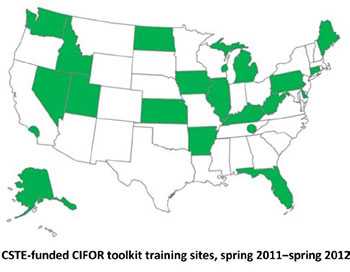CSTE Trains Public Health Staff to Improve Foodborne Disease Outbreak Response
48 million
Foodborne diseases affect approximately 48 million people across the United States each year.
22
Twenty-two state and regional sites received training to improve foodborne disease outbreak response in their jurisdictions.
3-step toolkit
All sites used the CIFOR toolkit’s three-step process to assess gaps and create action plans to improve their foodborne disease outbreak response.
1,068
1,068 public health professionals have participated in the trainings to date.
Foodborne diseases affect approximately 48 million people across the United States each year. Foodborne disease outbreaks can cause disruptions in public health agency activities and finances, while large outbreaks can derail an agency for weeks and strain public health resources.
The Council to Improve Foodborne Outbreak Response (CIFOR) published the Guidelines for Foodborne Disease Outbreak Response in 2009 and its accompanying toolkit in 2011 to describe outbreak response practices and functions. The guidelines aim to improve state and local public health response to foodborne disease outbreaks and, ultimately, reduce disease.
Funding from the Centers for Disease Control and Prevention’s Food Safety Office allowed the Council of State and Territorial Epidemiologists (CSTE) to host multidisciplinary trainings in 22 state and regional sites from spring 2011 through spring 2012. The trainings made use of the CIFOR toolkit to identify recommendations from the guidelines that would improve outbreak response in their jurisdictions. To date, 1,068 public health professionals have participated in the trainings.
What We Did
| All 22 sites used the CIFOR toolkit’s three-step process to describe their current activities in a specific focus area (such as communications, epidemiology investigations, or notification/ complaint systems) and identify areas for improvement, prioritize the CIFOR guidelines recommendations to address those areas, and outline steps to implement high-priority recommendations. Sites collaborated with other agencies in their jurisdictions to ensure training participants represented the range of roles involved in foodborne illness outbreak response, including epidemiologists, environmental health specialists, public health laboratorians, nurses, and regulators. Sites conducted one-day trainings, multiple-day trainings, or regional trainings. |  |
What We Accomplished
- More than 1,000 participants are now familiar with the CIFOR guidelines and toolkit.
- All 22 training sites created action plans for improvement and established primary points of contact and the timelines.
- Sites identified needed improvements in the areas of communication and coordination, post-outbreak debriefs and after-action reports, and investigation protocols.
- A majority of sites focused on similar areas of the guidelines—planning and preparation, investigation of clusters and outbreaks, and control measures.
- Trainings were well received by health agency staff, with comments including:
- “Utilizing the toolkit to guide a review of current practices was very valuable. We learned that we are doing a lot of things right, but also learned that standardization of foodborne outbreak detection and response practices statewide is helpful and can be improved.”
- “Enabling all of the jurisdictions to send in representatives from multiple disciplines allowed for excellent networking opportunities and face-to-face discussions. Local health jurisdictions have developed various strategies to enhance their foodborne outbreak response.”
- CSTE and CIFOR are revising the Guidelines for Foodborne Disease Outbreak Response to update the best practices and recommendations in order to continue improvements in state and local public health response to foodborne disease outbreaks and, ultimately, reduce disease burden.
For more stories, visit www.cdc.gov/stltpublichealth/phpracticestories
Publication date: 04/02/2013
More Information
For story information, contact
Lauren Rosenberg
Director of Marketing and Communications
Telephone: 770-458-3811
Email: lrosenberg@cste.org
For product information, contact
1600 Clifton Road NE, Atlanta, GA 30333
OSTLTS Toll-free Helpdesk: 866-835-1861
Email: OSTLTSfeedback@cdc.gov
Web: www.cdc.gov/stltpublichealth
The information in Public Health Practice Stories from the Field was provided by organizations external to CDC. Provision of this information by CDC is for informational purposes only and does not constitute an endorsement or recommendation by the US government or CDC.
- Page last reviewed: November 9, 2015
- Page last updated: November 9, 2015
- Content source:


 ShareCompartir
ShareCompartir



